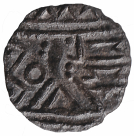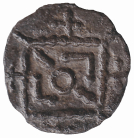Introduction to the Division of the R4 Sceatta into Classes


Coin ID 18 Timms Collection
The artwork, iconography and runes in the criteria for recognising an R4 sceat seems to be far from clear. When trying to establish the criteria for recognising an R4 sceat I have studied descriptions from:-
(1) Thrymsas & Sceattas in the Ashmolean Museum Oxford Vol 3 Metcalf,
(2) the Early Medieval Corpus database at the Fitzwilliam Museum Cambridge,
(3) SCBI Sylloge 63 British Museum London Gannon,
(4) Sceatta List Abramson (2012)
(5) The William Subjack Collection of Thrymsas Sceattas 5th June 1998 ITALO VECCHI Ltd London.
T & S Metcalf
In 1994 T&S vol 3 Metcalf states “Group 4, which is less homogenous, appears to be a continuation of Group 3,……”. Metcalf also comments that “Some specimens are virtually identical with Group 3 except that they lack the X or g in the legend,….” He shows (p511) two drawings of R4 examples, however, in Plate 24 401/402 shows pictures of two coins with symbols on the reverse quite different from the description on p511. The only coins shown in T&S with diagonally opposed “L’s” on the reverse within the beaded standard are clearly without a pyramidal neck so with present thinking were minted later in the “R” series continuum and have not been included in the survey.
EMC Fitzwilliam
The images of the coins registered on the EMC have been studied and the iconography and runes used to determine the criteria for recognising an R4 sceat. There are only seven images of “R4” coins in the category of R4, ignore the Series X coin put there by mistake. One coin from the classification “Uncertain Class” has been included.
Sylloge 63 Gannon
Gannon in Sylloge 63 Plate 28 description identifies the “Group R4 – Blackburn ‘G’. Obverse: bust with pyramidal neck with EPA inscriptions; zigzag behind formed by ᴧs; additional pellets and annulets.” The reverse is only briefly described as “variety of standards”. There are six coins described as “R4”.
Sceatta List Abramson
Abramson in Sceatta List 2012 p65 describes the obverse of an R4 (S/11/50) as “Radiate bust of crude style, right, runic epa EPA before, annulet and chevron behind, pyramidal neck rests on beaded exergual line". The reverse is described thus; Diamond standard containing symmetrical chevrons and lines and central annulet, cross pommée each side, diagonals at outer corners.
Subjack Sale Catalogue
There is an image and description of an “R5” in the 1998 Subjack Collection Sale Catalogue, this seems to show clearly what I consider to be typical “R4” characteristics. The coin shown is number 75 in the catalogue p18/19. It is listed as “R5 series AR 0.97 g. BMC type 2c. SPI in runes…….” The runes shown in the image are very clearly EPA! Other criteria are described as I would expect to see on an R4 sceat.
Classes
I have categorised the 18 coins in the survey as I perceive them to be, there are a number of charts and tables showing my conclusions. As can be seen the biggest group with similar symbols/runes are the coins with the ID numbers 13/14/15/16/17/18. I have designated this group “Class 1”. It is the ONLY class containing more than one coin! Coins with the ID 6 & ID 9 have not been allocated a class as the iconography/runes/symbols are very difficult to fully interpret with any degree of certainty. There are charts showing the different styles of both Obverse and Reverse styles. The most common combination is Obv1/Rev1.
Find Spots
No significant conclusion can be reach by looking at the find spots of the coins. Half of the coins (9) do not have a recorded find spot, two further examples have only a county or part of a county specified. Of the seven remaining two come from both Suffolk and Norfolk with one from East Sussex, one from Yorkshire and one from Hampshire.
Weights
With such a small number of coins with specified weights in the survey it is difficult to determine any significance. In Class 1 (the only class with more than one coin) there are no coins with a recorded weight of more than 0.97g. There are four coins with a weight of 1.00g or more. ID 3 = 1.12g, ID 10 = 1.08g, ID 7 + 1.05g and ID 11 weighing exactly 1.00g. Two coins weigh less than 0.70g, ID12 = 0.60g and ID 13 = 0.67g. See Chart.
In T & S vol3 (1994) p511 Metcalf comments "It seems likely that the average weight of Group 4 (R4) was deliberately reduced by about a quarter, but there was not enough evidence to show whether the change immediate or progressive."
Obverse
All coins in the survey have a Right facing head, All except coin ID 7 have the head above a four line beaded “pyramidal” neck. Some have a three pointed triangle crown visible above the head, others just a crown line which is often beaded. A head with a three pointed crown is termed a “Radiate Head/Bust” if, as in the later R series, there is no crown, it is referred to as a Runic Head/Bust. Often the runes depicted on the flan are quite stylised in format.
Runes
The most common configuration of runes before the head is EPA. Coins in Class 1 have the combination EPA with tops facing outwards reading in a clockwise manner. Two coins, ID 5 & ID 7, have the runes SPI. ID 5 has the combination of runes with tops pointing in/out/out. ID 7 has the combination out/out/out (all out). SPI read clockwise. The “A” rune, where used often appears stylised and losses the upward turn at the end of the upper arm. The runes are often shown in Pommé form. The two coins with the runic inscription SPI are the only ones in the survey with a Tufa or Fantail outside the standard on the reverse of the coin. Most runes are "Pommèe" (they end in a Pellet) as are the crosses outside of the Standard on the Reverse of the coin. Some coins have a pellet within the two downward legs of the M (E Rune). See image below with blue arrows.


ID 5 In/Out/Out ID 7 SPI Out/Out/Out

Tufa or Fantail at the top of the coin above the square beaded Standard.
This Tufa has only one pellet visible but most have three,
however the Tufa does extend over the flan edge.

ID 11, 63/645 is in poor condition consequently the runes are difficult to read, however, it appears to possibly have the runic combination of T epa with the E & P Ligate or Bind, see chart page. The reverse on this coin is of the most common Reverse Type 1. See chart. “T’s” appear along with runes on many of the R series coins. There is no rune in the shape of a capital T in the 28 character Anglo Saxon futhorc used at that time in the southern kingdoms of “England” (AD 713 – AD 749).
Symbols
Most coins have a double horizontal chevron pointing towards and behind the head, ID 3 has only one “chevron” however this is actually a barred horizontal A pointing towards the head. This is often seen in the earlier R Series coins. Coupled with the somewhat unusual symbols on both of the Obverse and Reverse I have doubts as to whether this coin is indeed an R4. I have included this coin in the survey at present and allocated it the class number 4, it has the configuration Obv2/Rev8. See Chart.
Reverse
As with the Obverse the most common of the styles of Reverse is the Class 1 Reverse (Rev1). Coins ID 5 and ID 7 appear to possibly have a Tufa on the outside of one of the sides of the beaded standard. ID 5 has unusual symbols both within and outside the standard. Some coins have an unbarred cross pommé on each side of the standard more common in the R3 series, on others the crosses are barred. There are a variety of symbols within the standard on the reverse of some coins. See chart.


Typical R4 Class 1 Reverse ID 5 Unusual Symbols
Within Standard




